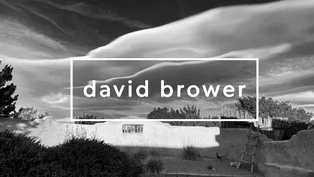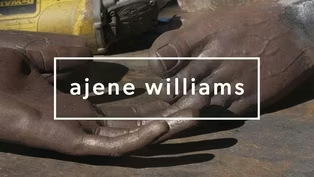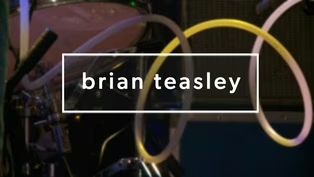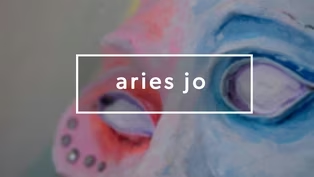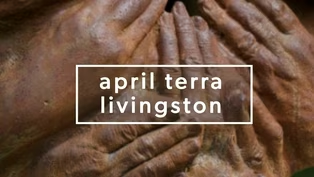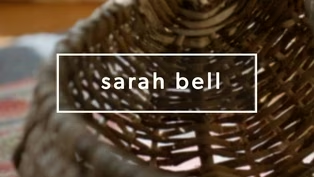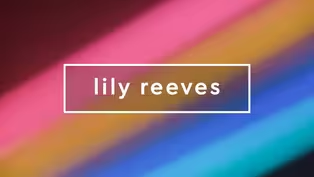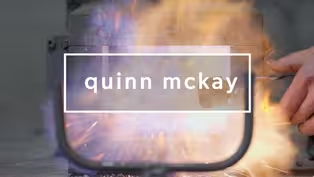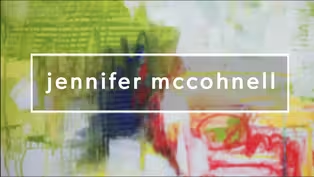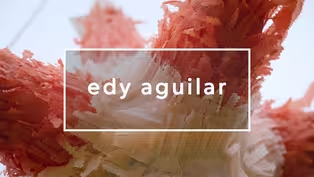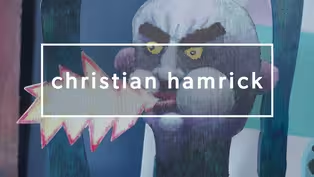Monograph
Jenny Fine
Clip: Season 7 | 7m 19sVideo has Closed Captions
Visual artist, Jenny Fine, transforms memory into visual narrative.
How do we preserve family stories across generations? Visual artist Jenny Fine explores this through photo-based installations that blend family history, Southern lore, and personal myth. From cotton fields to underwater dreamscapes in her grandmother’s pool, she transforms memory into immersive, narrative worlds rooted in Southern culture.
Problems playing video? | Closed Captioning Feedback
Problems playing video? | Closed Captioning Feedback
Monograph is a local public television program presented by APT
Monograph
Jenny Fine
Clip: Season 7 | 7m 19sVideo has Closed Captions
How do we preserve family stories across generations? Visual artist Jenny Fine explores this through photo-based installations that blend family history, Southern lore, and personal myth. From cotton fields to underwater dreamscapes in her grandmother’s pool, she transforms memory into immersive, narrative worlds rooted in Southern culture.
Problems playing video? | Closed Captioning Feedback
How to Watch Monograph
Monograph is available to stream on pbs.org and the free PBS App, available on iPhone, Apple TV, Android TV, Android smartphones, Amazon Fire TV, Amazon Fire Tablet, Roku, Samsung Smart TV, and Vizio.
Providing Support for PBS.org
Learn Moreabout PBS online sponsorship(soft gentle music) I'm Jenny Fine, and I'm an artist.
I am definitely a hoarder in some ways, you know, but I think I'm more of a collector, you know?
I tend to like see or find materials, and if I find the material beautiful or that I think, "Oh, this could be used to create a coral reef" or something, then I will drag out my trailer and go pick it up off the side of the road.
I began studying photography after I took a break from school.
I was very lost.
I didn't know what I wanted to do.
The opportunity to move to China came up, and so I went.
And before I left, my mom bought me a 35-millimeter camera.
The camera was my closest ally during that time, and I began to really love photography and its ability to capture the outside world.
And so I came back to the University of Alabama and began studying photography with Gay Burke.
But I would always talk to her about how the photograph wasn't enough.
I was really interested in photographing people.
Like, I wanted the body in the image.
And so I would often take my grandmother out with me.
And so as I was working with the focus and the aperture and the shutter speed and ISO and all of that, she would be telling me stories.
So it's sort of mythology around who I come from.
And so I began to then try to use my family to reenact these sort of family narratives.
And it made it easier for us to pretend to be ourselves.
Like, my family, you know, the relationships are very challenging, you know, and complicated, which in a lot of ways I think really mirrors the culture that we find ourselves in.
Anyway, so she passed away.
So those images are actually the last living images of my grandmother.
And it goes back to that whole, like the photograph as a stand-in, where the photograph becomes presence and absence at the same time.
And so I began to think about ways in which I could create photographic atmospheres that she could be placed within.
And then I started thinking about, how can I reverse the camera's crop and add space and time to the photograph?
And so then I started thinking about creating her photograph as a costume.
That sort of became the impetus or the birth of Flat Granny, because I thought this was a really wonderful way to be able to continue collaborating with her beyond death.
As my grandmother got older, she started to have dementia, so she lost a lot of her recent memory, but she remembered a lot of, you know, her history.
In 1968, she was Woman of the Year, and you ride a parade float down Main Street.
And in the middle of Main Street in my hometown is the Boll Weevil Monument.
And I just thought that was a really interesting story.
But it also was this idea of a moving image, this parade float moving through this procession.
And so I created the landscape of my dad's fields in cotton.
So it was really about what was going on around me and my history.
But I also, I began to gain other perspectives of the boll weevil, and how it is a way of whitewashing and erasing the very important work that George Washington Carver did traveling through all of these counties.
The history of the boll weevil that I have been told growing up is that the boll weevil came and it destroyed the cotton.
And so somebody got a great idea to switch over to peanuts.
So I learned a lot from this narrative.
I learned a lot, and I'm still learning a lot from it.
The "Synchronized Swimmers" came from my experience of swimming in my grandmother's pool in her backyard.
And that was Grandmother Fine's house.
The rain would come and she would come up and tell us to get out of the water, and we'd go get under the safety of the metal umbrella.
(chuckles) And then she would tell us stories.
And, again, she was a teacher.
Teaching was very seamless for her.
The stories that she told us were often stories from history, and they were often pretty dark stories.
Like, she would often tell us about swimming witches and trial by water.
She taught us about Odysseus and the Sirens.
And so I started thinking about these ideas and themes of women in water.
And so I would start dreaming.
I was in like her pool.
And I would like swim, and as I got deeper, it would turn into like underwater, the ocean or whatever.
Anyway, and that was sort of a repetitive dream over time.
I knew Flat Granny was gonna be in the image, and I also wanted Granny Caldwell.
And so I started thinking about the Sirens and when Odysseus passed by, and they were unable to lure him in, I was like, "Well, what happened to them?"
And I think that they're on the bottom of the ocean floor eating hot dogs.
That's just what I think.
(laughs) But anyway, long story short, I decided that I wanted to create something that I had personally within my body experienced, so I started working with the narrative of water.
And then my sister died.
She was one of the girls that would swim with us.
And I made these three oysters.
Because I'm the middle of two girls, and so like one of the oysters died.
And so, I don't know, it's evolved.
At the show at Alabama School of Fine Arts, one of the oysters was on its side with these legs, these tape cast legs of my legs.
Instead of being a performing oyster, she just laid in the scene or whatever.
And I didn't realize I was doing that until it's done, you know?
And that's how a lot of my work is, like it happens really intuitively.
I learned, and so I crossed them.
And you couldn't see this at the time, but... Anyway, all to say the work has turned into a lot about care and who gets it and who doesn't get it, who deserves it.
It rounds out a very complicated narrative.
And being able to tell stories from a small community, American stories that inform the larger understanding of the South, which as (indistinct) says is the soul of the nation, the more that we can tell, the more that we can understand who we are and change what we don't like.
(soft mellow music)
Video has Closed Captions
Clip: S7 | 6m 50s | Artist David Brower on his interdisciplinary creative journey. (6m 50s)
Video has Closed Captions
Clip: S7 | 5m 22s | Metal Arts, Ajene Williams transforms cold scrap metal into warm, joyful sculptures. (5m 22s)
Video has Closed Captions
Clip: S7 | 11m 49s | A life of bringing people together to make and experience music. (11m 49s)
Video has Closed Captions
Clip: S7 | 6m 28s | Using art to process grief and transform it into a life of authentic joy. (6m 28s)
Video has Closed Captions
Clip: S7 | 7m 33s | April Terra Livingston gives form to ideas through many art forms to educate the world around her. (7m 33s)
Video has Closed Captions
Clip: S7 | 8m 43s | Sarah Bell creates intuitive, woven art that captures the essence of place and season. (8m 43s)
Video has Closed Captions
Clip: S7 | 7m 10s | Birmingham native, Lily Reeves captures sculptures of light in her neon studio. (7m 10s)
Video has Closed Captions
Clip: S7 | 5m 43s | Birmingham blacksmith Quinn McKay transforms nature into elegant, functional metalwork. (5m 43s)
Video has Closed Captions
Clip: S7 | 7m 19s | Visual artist, Jenny Fine, transforms memory into visual narrative. (7m 19s)
Video has Closed Captions
Clip: S7 | 7m 58s | Alabama based conceptual artist, Jennifer McCohnell. (7m 58s)
Video has Closed Captions
Clip: S7 | 5m 36s | Piñata maker and multimedia artist, Edy Aguilar, in Northern Alabama. (5m 36s)
Video has Closed Captions
Clip: S7 | 4m 56s | Christian Hamrick's childhood home became both canvas and classroom, fostering boundless creativity. (4m 56s)
Video has Closed Captions
Clip: S7 | 6m 35s | Alabama native Vice Cooler is a multifaceted artist based in LA. (6m 35s)
Providing Support for PBS.org
Learn Moreabout PBS online sponsorshipSupport for PBS provided by:
Monograph is a local public television program presented by APT
